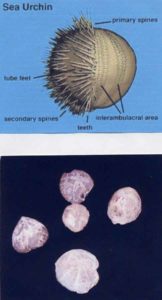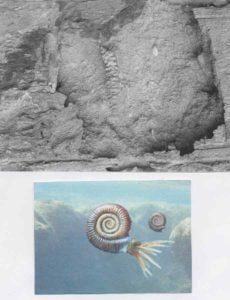
Millions of years ago much of the earth’s surface was covered with large areas of shallow seas, swamps or marshes. Over the succeeding millennia, as the land and sea animals inhabiting these areas died, their carcasses were covered with a variety of sediments, causing their remains to become fossilised. Subsequent erosion and movements in the earth’s crust as it fractured and folded have exposed rock strata containing those fossils.
 That Fovant was no exception to this seismic activity is hard to imagine, yet the evidence exists in the shape of the geological structure of our village. In the south the underlying rock is obviously chalk. This material, over 1,600 feet thick, was laid down from marine deposits during the Cretaceous period, some 100 million years ago. The village itself is in a north-south valley bounded on both east and west by a wide terrace of Greensand, a rock which also dates from the Cretaceous period, although of a lagoon rather than a marine environment. More detail is contained on the Geology page
That Fovant was no exception to this seismic activity is hard to imagine, yet the evidence exists in the shape of the geological structure of our village. In the south the underlying rock is obviously chalk. This material, over 1,600 feet thick, was laid down from marine deposits during the Cretaceous period, some 100 million years ago. The village itself is in a north-south valley bounded on both east and west by a wide terrace of Greensand, a rock which also dates from the Cretaceous period, although of a lagoon rather than a marine environment. More detail is contained on the Geology page
 The fossilised sea urchins on the left were all found in the Fovant area. They first appeared many millions of years ago and the species is still alive in our seas today
The fossilised sea urchins on the left were all found in the Fovant area. They first appeared many millions of years ago and the species is still alive in our seas today
Set into the wall of Knapp Cottage on the Dinton Road, part of a fossilised cockle shell (on the right), beside which can be see the equally fossilised impression it has made before the sediment it fell into became hard. Cockles are still gathered from our sea shores.
 On the left, fossil remains in the wall of Greycroft in Fovant High Street before that part of the wall was restored. It looks like the spine of an animal, but it is much more likely to be the cross-section of an ammonite, like the now extinct sea creature in the lower picture.
On the left, fossil remains in the wall of Greycroft in Fovant High Street before that part of the wall was restored. It looks like the spine of an animal, but it is much more likely to be the cross-section of an ammonite, like the now extinct sea creature in the lower picture.
It seems that initially ‘Fovant’ was a very watery place.
Click on the links below to find more information on the origins of Fovant:
